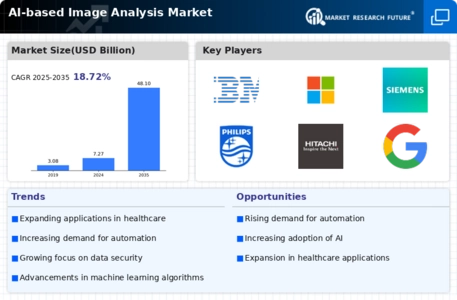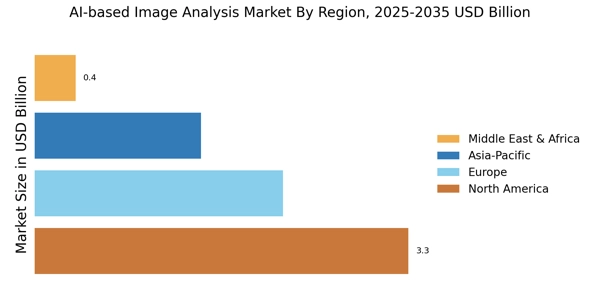Rising Demand for Automation
The AI-based Image Analysis Market is experiencing a notable surge in demand for automation across various sectors. Industries such as manufacturing, retail, and healthcare are increasingly adopting AI-driven image analysis solutions to enhance operational efficiency. For instance, the market for AI in manufacturing is projected to reach USD 16 billion by 2025, driven by the need for automated quality control and predictive maintenance. This trend indicates a shift towards leveraging AI technologies to streamline processes, reduce human error, and improve productivity. As organizations seek to optimize their workflows, the integration of AI-based image analysis tools becomes essential, thereby propelling the growth of the market.
Expansion of Smart City Initiatives
The expansion of smart city initiatives is significantly impacting the AI-based Image Analysis Market. Urban areas are increasingly implementing AI technologies to enhance infrastructure, transportation, and public services. For example, AI-driven image analysis is being utilized for traffic management and urban planning, contributing to more efficient city operations. The smart city market is expected to grow to USD 2.5 trillion by 2025, indicating a substantial opportunity for AI-based image analysis solutions. As cities strive to improve quality of life and sustainability, the integration of AI technologies becomes paramount, thereby fostering growth in the image analysis market.
Advancements in Machine Learning Algorithms
The AI-based Image Analysis Market is significantly influenced by advancements in machine learning algorithms. These innovations enable more accurate and efficient image processing capabilities, which are crucial for applications in sectors like healthcare, automotive, and security. For example, the implementation of deep learning techniques has improved diagnostic accuracy in medical imaging, leading to better patient outcomes. The market for AI in healthcare is expected to grow at a compound annual growth rate of 42% from 2023 to 2030, highlighting the potential of these technologies. As machine learning continues to evolve, the demand for AI-based image analysis solutions is likely to expand, fostering further growth in the industry.
Growing Need for Enhanced Security Solutions
The AI-based Image Analysis Market is witnessing a growing need for enhanced security solutions, particularly in sectors such as public safety and cybersecurity. The increasing prevalence of security threats has prompted organizations to adopt AI-driven image analysis technologies for real-time monitoring and threat detection. For instance, the market for AI in security is projected to reach USD 30 billion by 2026, as businesses seek to leverage advanced analytics for improved safety measures. This trend underscores the importance of AI-based image analysis in developing proactive security strategies, thereby driving market growth. As security concerns escalate, the demand for innovative image analysis solutions is likely to rise.
Increased Investment in Research and Development
Investment in research and development is a critical driver for the AI-based Image Analysis Market. Companies are allocating substantial resources to innovate and enhance their AI capabilities, which is essential for maintaining competitive advantage. In 2025, it is estimated that global spending on AI research will exceed USD 100 billion, reflecting the growing recognition of AI's transformative potential. This influx of funding supports the development of sophisticated image analysis tools that can cater to diverse applications, from surveillance to autonomous vehicles. As organizations prioritize R&D, the AI-based image analysis market is poised for robust growth, driven by continuous innovation and technological advancements.

















Leave a Comment